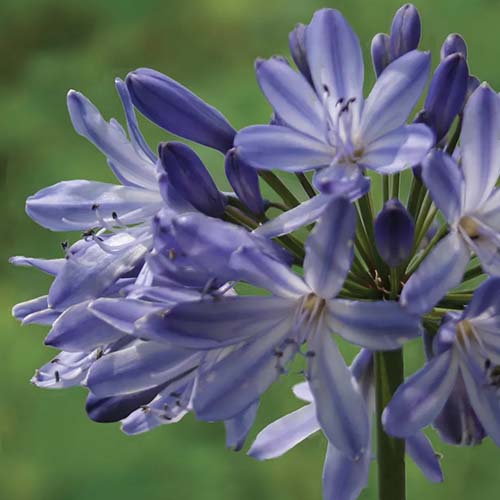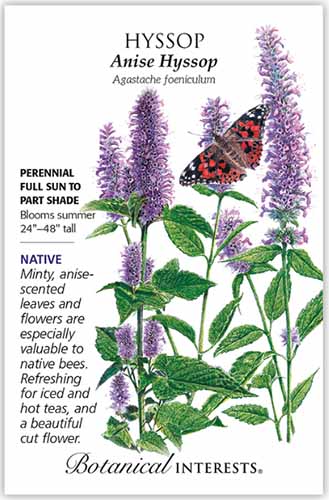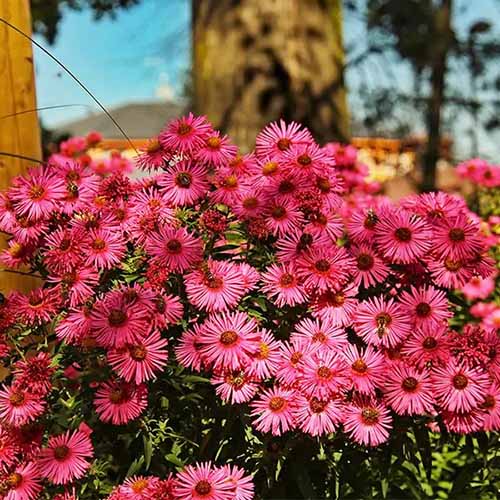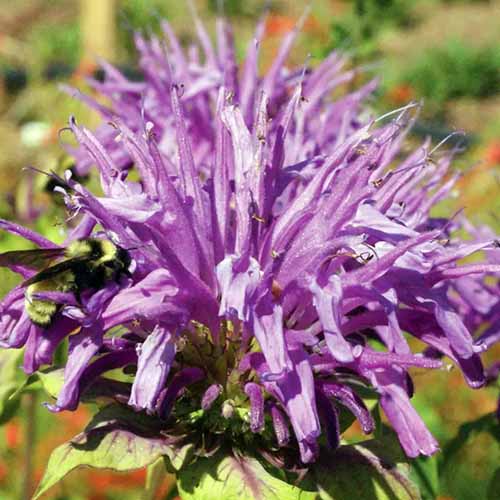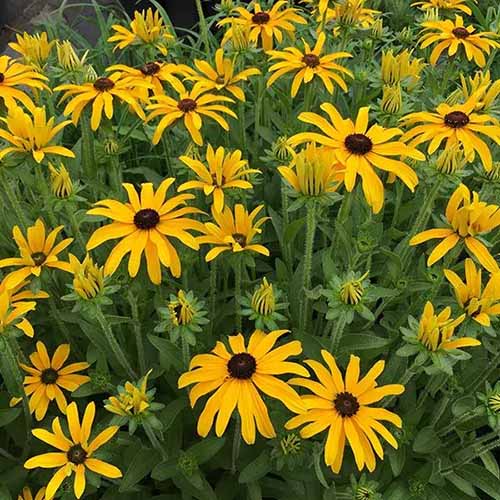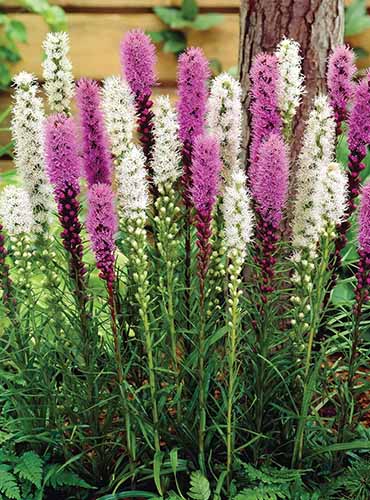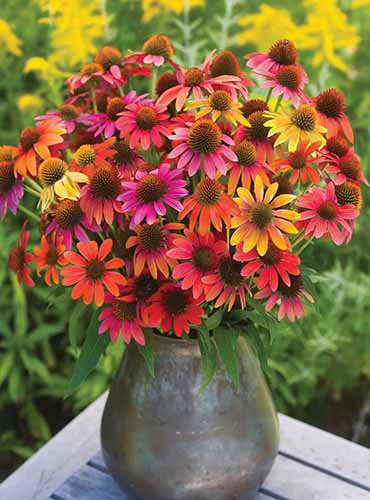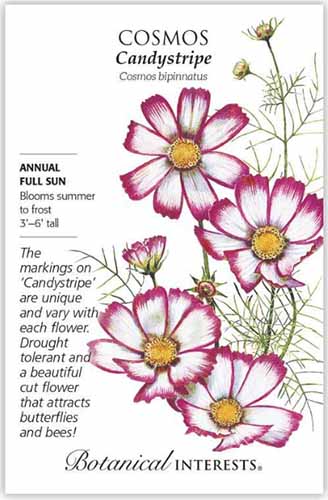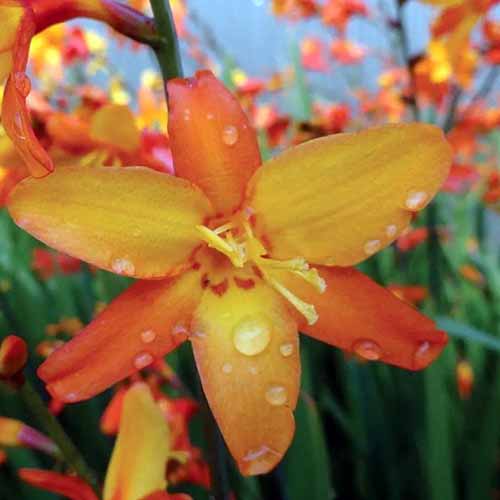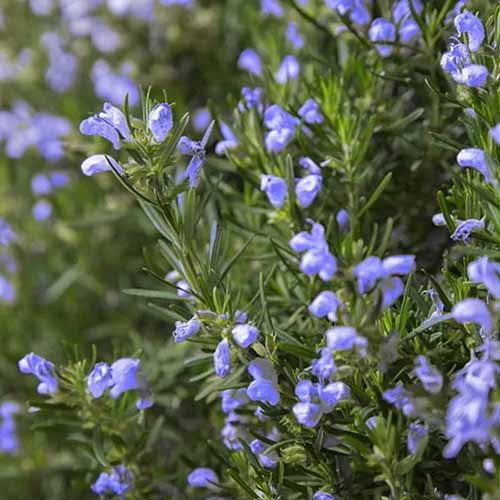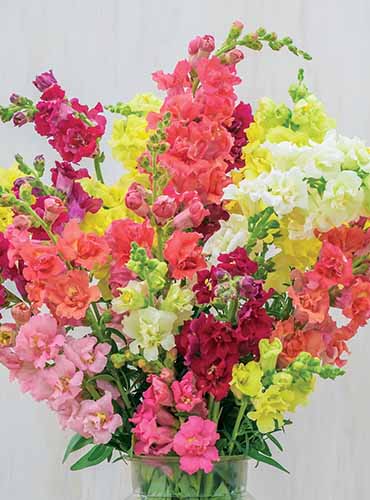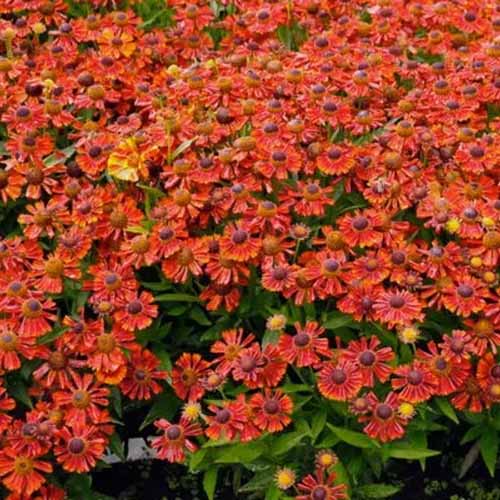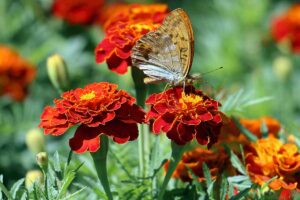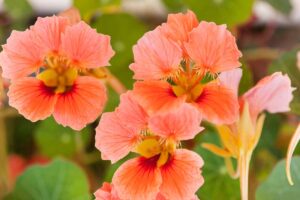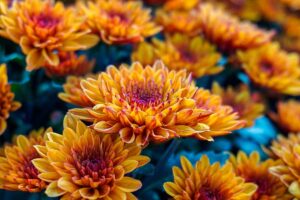Dahlias (Dahlia spp.) add pizzazz to the landscape with bold single or double blooms in a varied color palette, including black, orange, pink, purple, red, white, and striking multicolor combinations.

We link to vendors to help you find relevant products. If you buy from one of our links, we may earn a commission.
These non-native, tender, tuberous flowering bulbs are perennials in USDA Hardiness Zones 8 to 11 and annuals in Zones 3 to 7, though they may make it through the winter with added protection in Zone 7, or the tubers can be lifted for storage and replanting.
Dahlias bloom from summer to fall. They prefer full sun locations and organically rich, moist, well-draining soil with a slightly acidic to neutral pH of 6.5 to 7.0.
The sizes of cultivated varieties range from nine to 60 inches tall and 12 to 24 inches wide. At season’s end, many devoted gardeners lift their much-loved tubers to store for the winter, divide as needed, and replant the following spring.
Flowers with such eye-popping visual appeal can stand alone or grace the company of garden companions that share their cultural requirements.
In our guide to growing dahlias, you’ll find all you need to know to fill your gardens with showy, richly-hued blooms.
This article focuses on 19 of the best flowering companions for dahlias.
Here they are, from A to Z:
19 of the Best Dahlia Companions
Let’s jump right in and meet them!
1. Agapanthus
Perennial agapanthus (Agapanthus spp.) has rounded clusters of lily-like blue, violet, or white flowers. It is suited to Zones 6 to 11, where it blooms in full sun in the spring and summer.
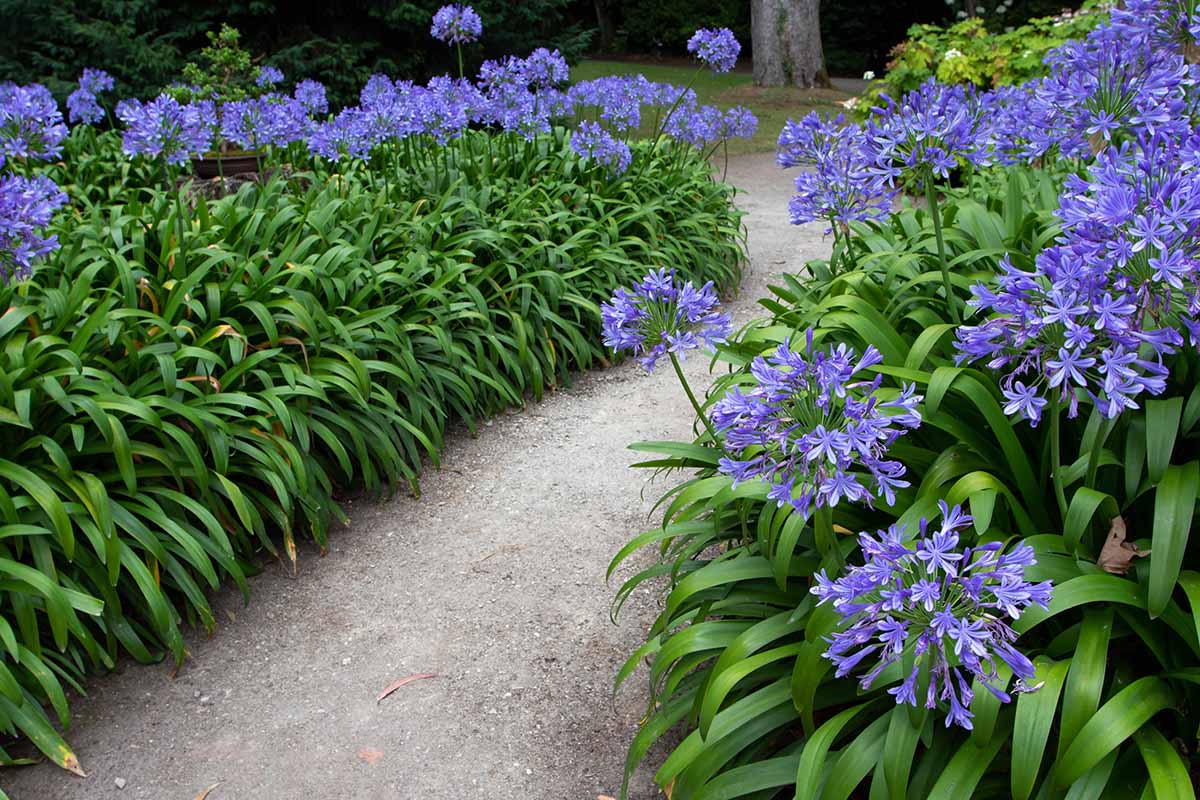
Mature dimensions are 22 to 44 inches tall and wide. Shorter cultivars are suited to beds and borders, while the tallest are excellent rear bed anchors.
Bare root Agapanthus ‘Blue Heaven’ is available from Burpee.
Our guides to growing agapanthus include complete cultivation instructions. And you can learn more about 25 of the best agapanthus varieties in our roundup.
2. Allium
Allium (Allium spp.) is a native perennial rhizomatous bulb with round flower heads comprised of starlike blooms in shades of blue, green, pink, purple, red, white, or yellow.
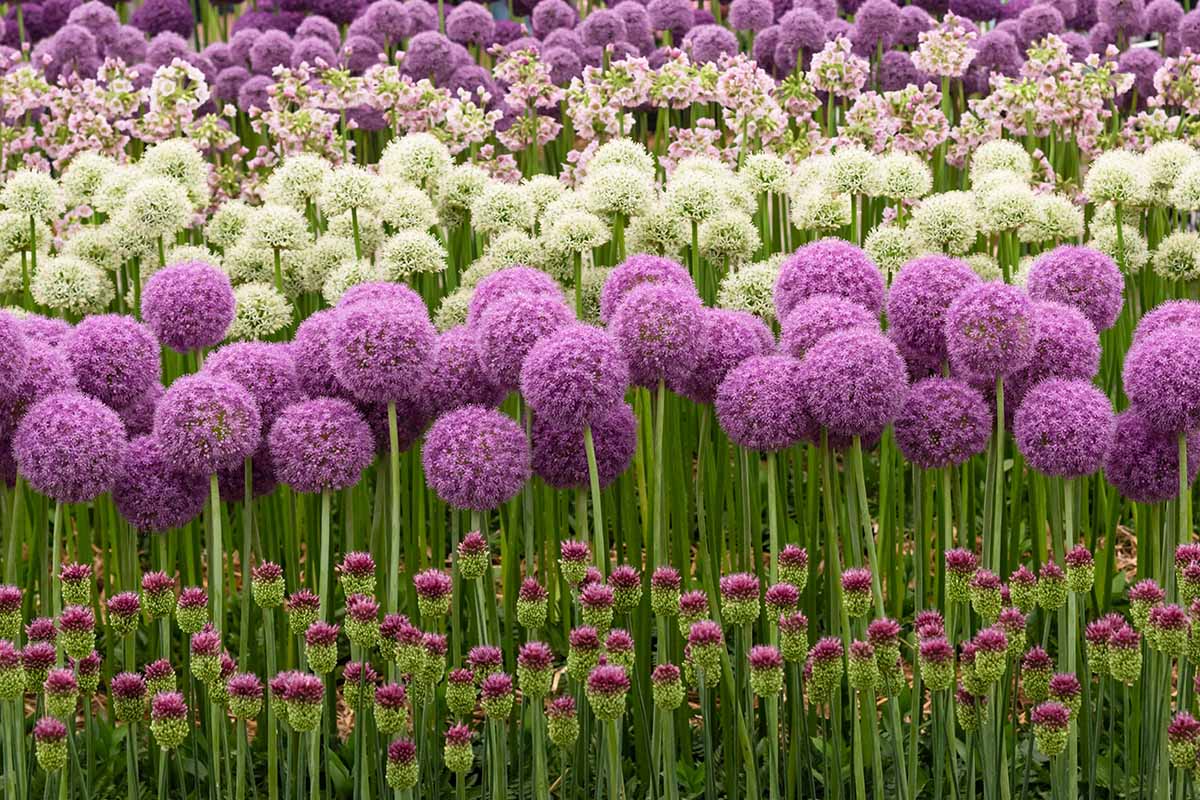
Perfect for Zones 3 to 9, choose varieties that bloom in spring, summer, or fall in full sun to part shade.
Plants reach one to five feet tall with a spread of one to two feet. Mix or match among dahlias for texturally-rich balloon-like pops of color.
You can find ‘Serendipity,’ a delightful purple cultivar, available from Nature Hills Nursery in #1 containers.
For more information, consult our complete guide to growing ornamental alliums.
3. Anise Hyssop
Perfect for Zones 4 to 9, the blue, lavender, or purple multi-flowered spikes of native perennial anise hyssop (Agastache foeniculum) are a cheerful summer sight in full-sun placements.
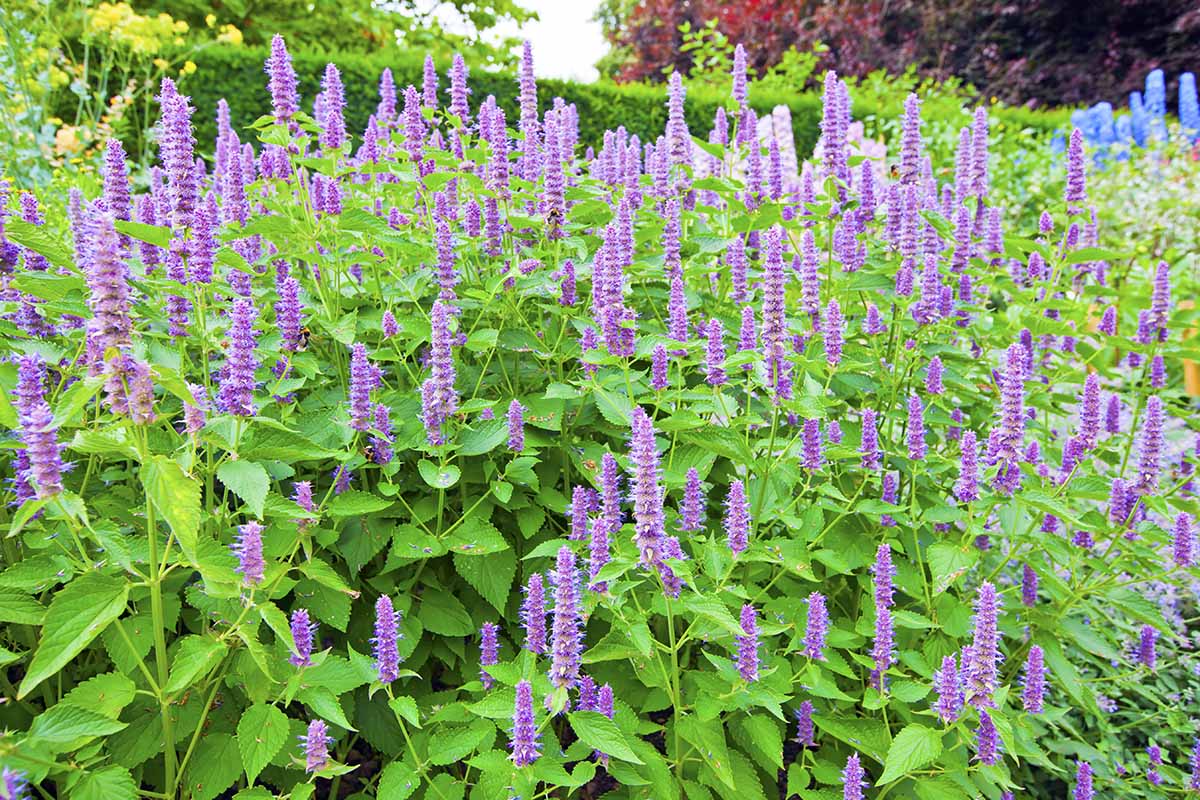
Maturing to heights of two to four feet with spreads of one and a half to three feet, they make a stout contrasting vertical statement among rounded dahlia blooms.
You can find 100- or 250-milligram packets of seeds available from Botanical Interests.
See our guide to growing anise hyssop for cultivation instructions.
4. Aster
Asters (Aster, Doellingeria, Eurybia, Ionactis, and Symphyotrichum spp.) offer late summer to fall color in Zones 4 to 8, where they thrive in full sun and tolerate dappled shade. Many are native species.
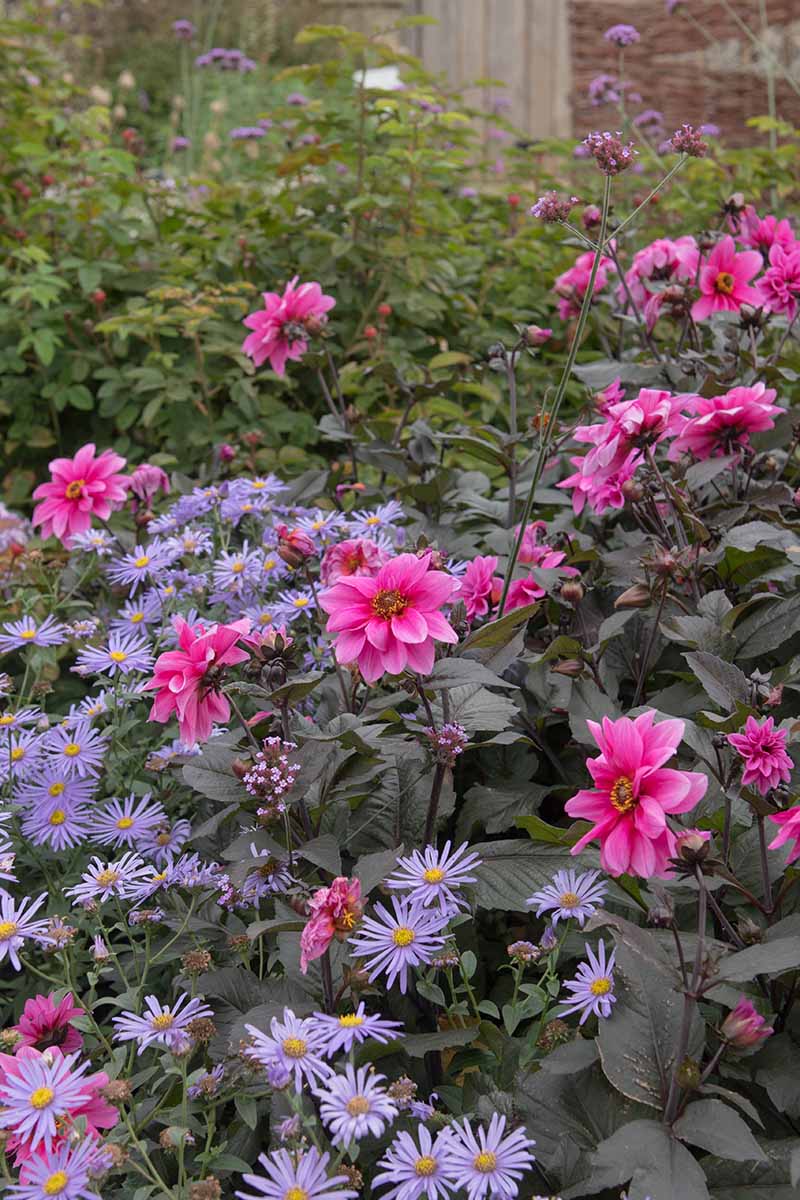
You’ll find an aster height for every need, ranging from six to 72 inches with a spread of eight to 36 inches.
In shades of blue, pink, purple, and white, masses of small, daisy-like blossoms perform a supporting role as texturally soft filler between or behind bold, center stage dahlias.
‘Alma Potschke’ is a New England aster that blooms with a profusion of bright pink flowers.
Find plants available at Nature Hills Nursery.
We have multiple guides to growing asters available for further information.
5. Bee Balm
With petals like fireworks, the rich red, pink, or purple hues of native perennial bee balm (Monarda spp.) play well with dahlias’ equally vivid tones.
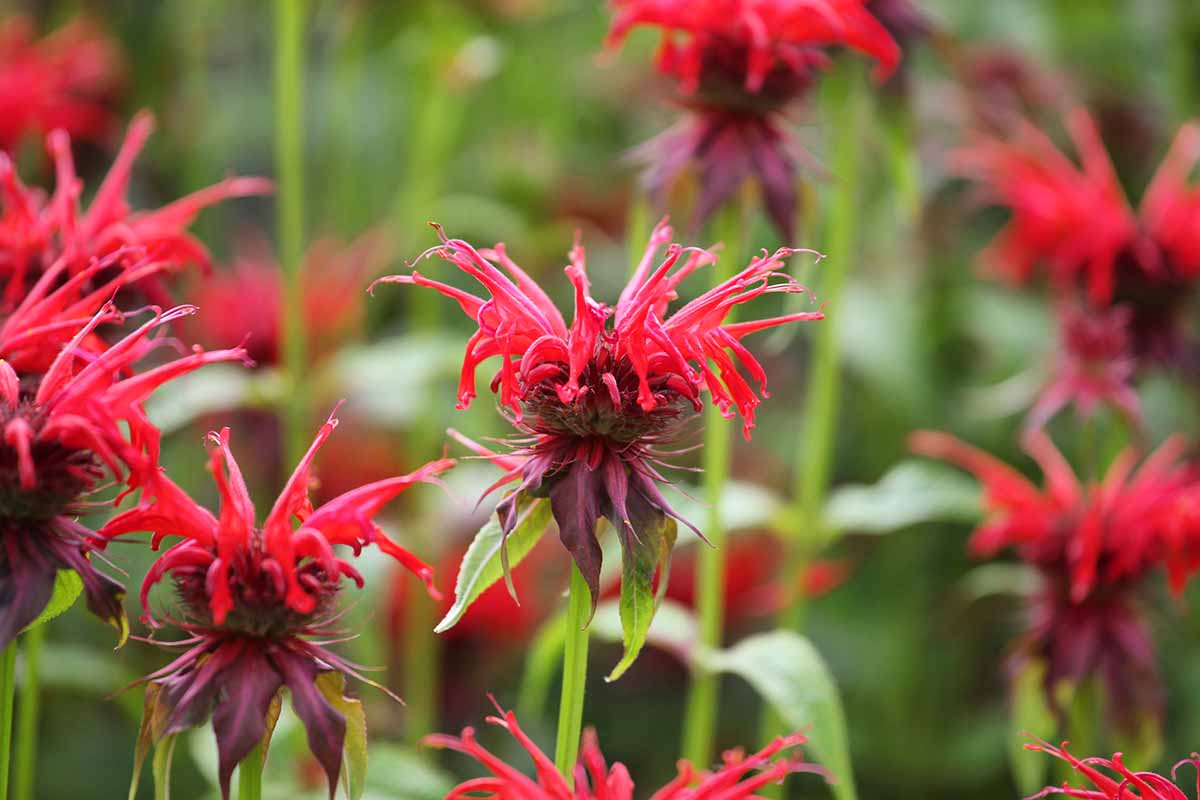
Suited to full-sun and part-shade placements in Zones 3 to 9, this summer bloomer never disappoints with sturdy stems that soar from three to five feet tall and a spread of 18 to 36 inches.
You can find packets of purple-flowered M. fistulosa seeds available at Burpee.
See our bee balm growing guides for all you need to know.
6. Black-Eyed Susan
Native perennial black-eyed Susan (Rudbeckia hirta) has golden, orange, or red petals surrounding deep brown center disks for swaths of sizzling full-sun summer color in Zones 3 to 9.
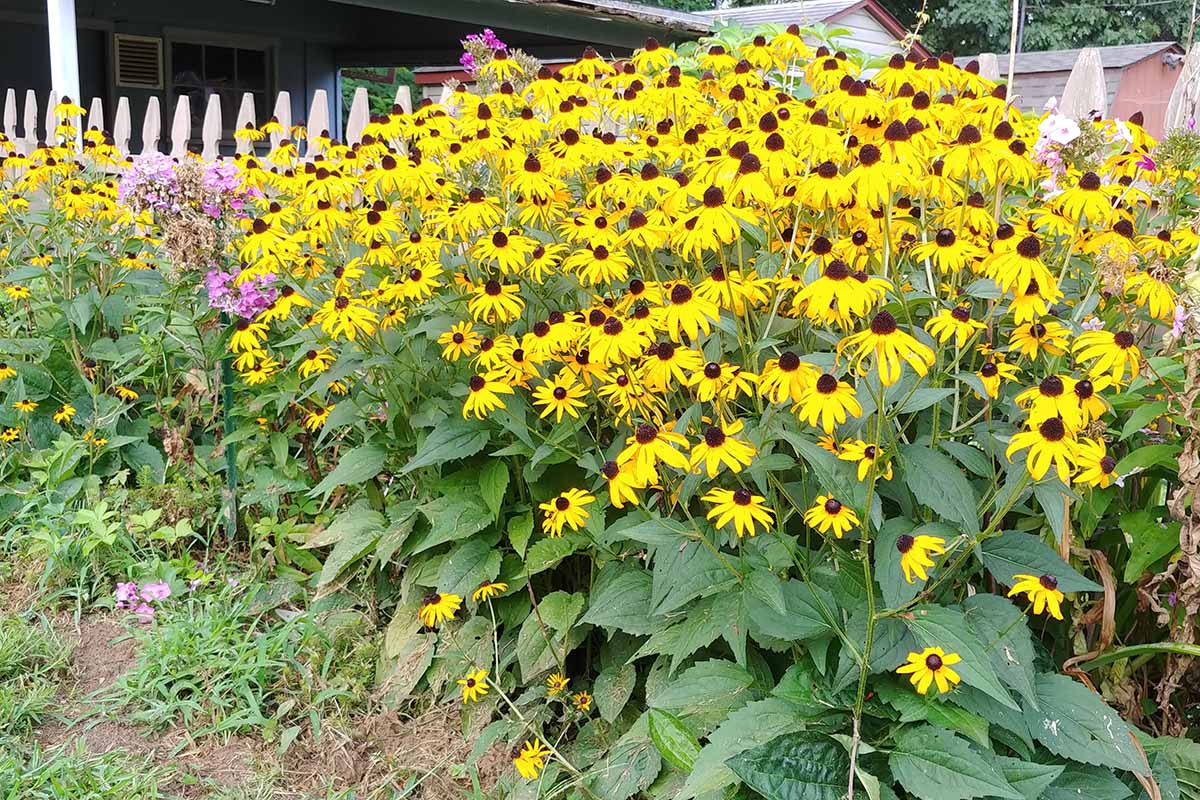
With moderate proportions, it stands two to three feet tall and 12 to 18 inches wide, a versatile bed and border companion for mid-section placements paired with medium and short dahlias.
‘Glitters Like Gold’ is a yellow cultivar that’s available at Nature Hills Nursery in #1 containers.
See our black-eyed Susan growing guide and our roundup of favorite varieties for more information.
7. Blazing Star
The striking pinkish-purple flower spikes of native perennial blazing star (Liatris spicata) light up sunny gardens from late summer to fall in Zones 3 to 9.

Regal heights of two to four feet and a narrow nine- to 18-inch spread make it well-suited to anchor placements in beds.
It also performs exceptionally well when interplanted with dahlias to create an arresting alternating pattern that showcases the unique forms of each.
White-flowering blazing star cultivars are also available.
You can find a mixture of purple and white blazing star bulbs available at Burpee.
Our guide to growing blazing star has detailed instructions.
8. Common Switchgrass
Common switchgrass (Panicum virgatum) is a native ornamental grass for Zones 5 to 9 that prefers full sun and tolerates part shade.
A pinkish haze seems to hover like a soft pastel cloud over each clump of narrow grass blades from midsummer through fall as it blooms and sets seed.
Mature dimensions are three to six feet tall and two to three feet wide.
With a spectacular combination of height, airiness, and columnar form, this companion performs best as an accent in informal drifts, backdrop to graduated height foreground plantings in expansive beds, and a foundation anchor.
P. virgatum ‘Heavy Metal’ features blue-green foliage and tops out at a mature height of three to four feet and spread of two to three feet.
You can find plants in #1 containers available at Nature Hills Nursery.
9. Coneflower
With daisy-like petals in shades of orange, purple, red, or white, native perennial coneflowers (Echinacea spp.) are a Zone 5 to 9 favorite.
With full sun to partial shade, plants bloom from summer to fall, when the cone-like seed heads attract foraging songbirds.
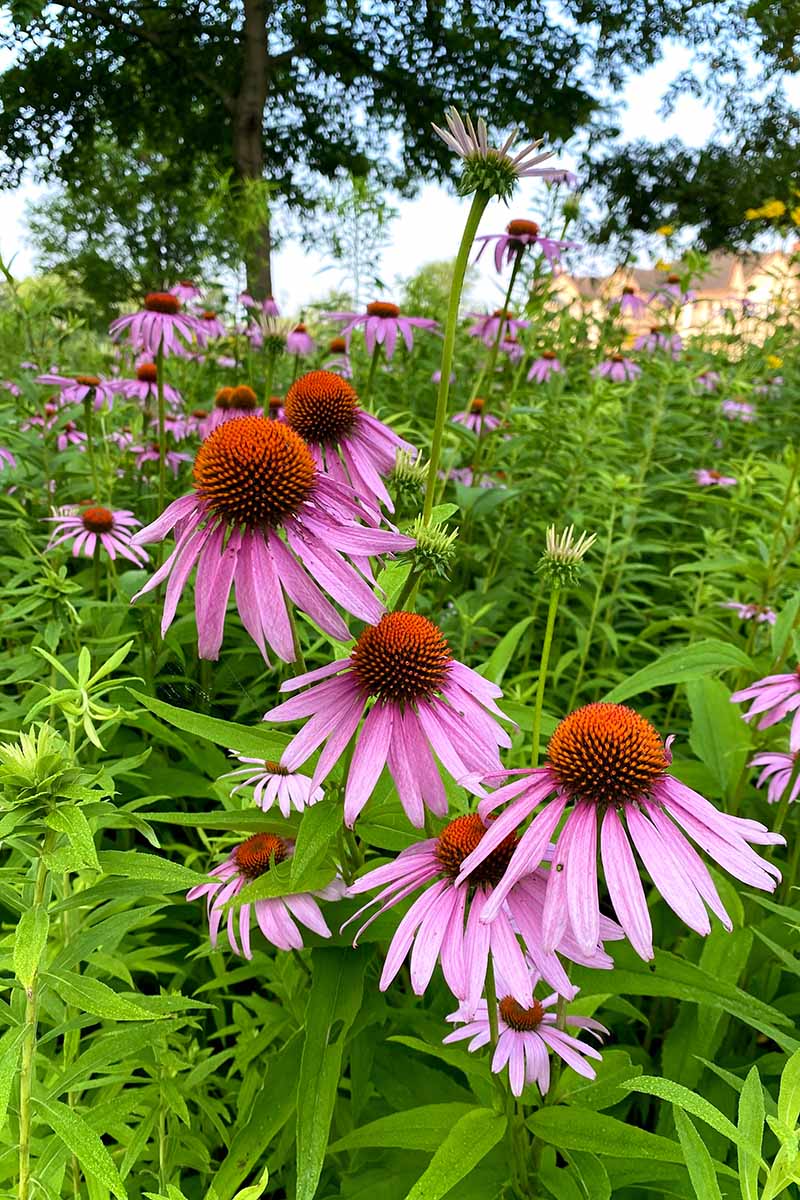
Standard plants mature to three to four feet tall and one to three feet wide while dwarf varieties may be as small as six to 12 inches tall and wide.
Select by height and color to complement or contrast with dahlias in beds, borders, and drifts where their compact uniformity contributes to a manicured arrangement.
The Warm Summer Mix features orange, yellow, red, rose, purple, and cream flowers. Find packets of 10 seeds or a bundle of four plants available from Burpee.
Our guides to growing coneflowers have all you need to get started.
10. Cosmos
A summer sensation in full sun, the delicate, squarish petals of cosmos (Cosmos spp.) may be orange, red, pink, purple, red, yellow, white, or bicolored.
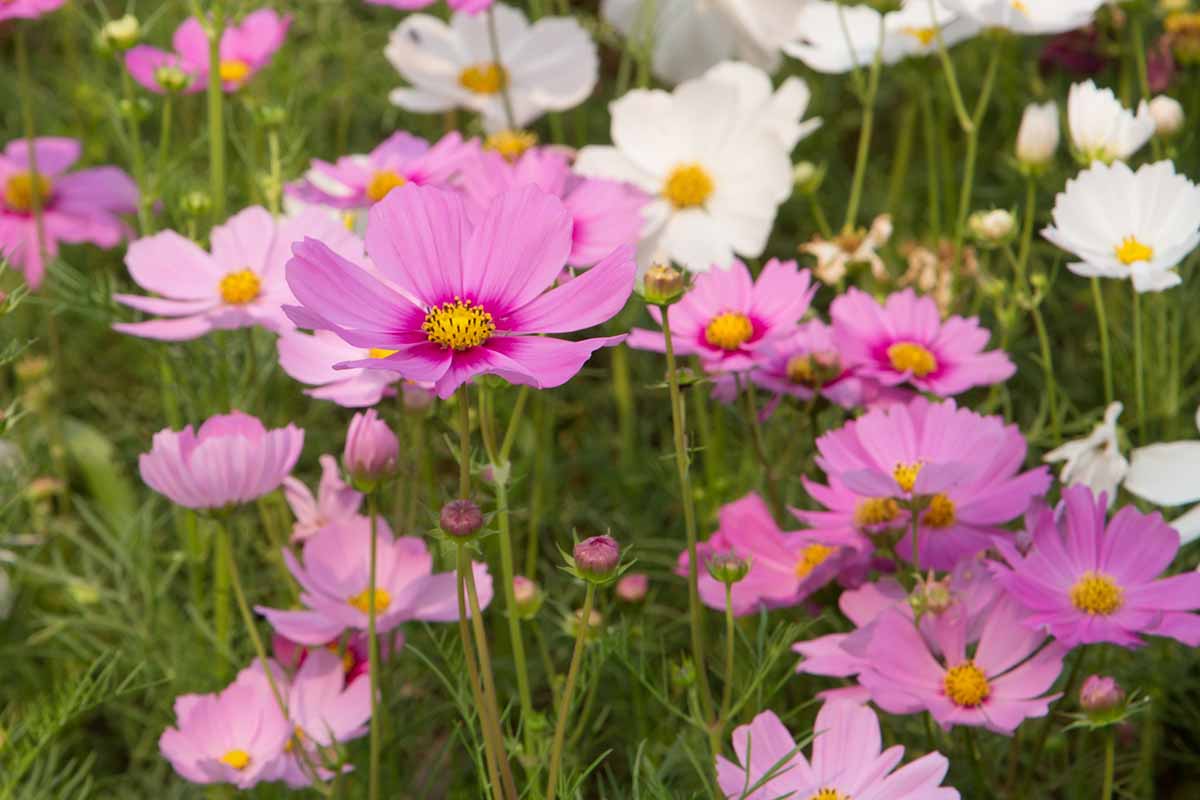
An annual for Zones 2 to 11, it reaches heights of one to six feet and widths of one to three feet, its slender stems reacting to the slightest breeze with a whisper of movement to draw the eye into the garden.
Intersperse these among dahlias of corresponding heights for an informal cottage garden ambiance.
‘Candystripe’ is a bicolored cultivar with two-tone pink and white petals. Seeds in 500-milligram packets are available from Botanical Interests.
See our cosmos growing guide and our roundup of 25 favorite cultivars for more information.
11. Crocosmia
For full sun to part shade, summer-blooming crocosmia (Crocosmia pottsii) is best suited to Zones 6 to 9. It offers dainty, lily-like, orange-red blossoms atop arching racemes originating in spear-like green foliage.

With a mature height of one to three feet and a spread of one to one and a half feet, the sharply angled leaves are impressive.
The small hovering flowers look like tiny exotic birds, completing a brilliant contrast to the dahlias’ rose-like blooms and simple leaves. Alternate the two in plantings for a dynamic rhythm.
You can find packets of three ‘Orange Pekoe’ bulbs available at Burpee.
Find tips on growing crocosmia here.
12. Floss Flower
Lavender-blue, pink, red, or white floss flower (Ageratum houstonianum) is a low-profile annual for Zones 2 to 11 that thrives in full sun and blooms from summer to fall.
Fuzzy button-like blooms bring textural contrast to the smooth, wax-like petals of dahlias.
Mature heights range from six to 24 inches with a spread of six to 12 inches. Create a ribbon of contrasting or complementary color in front of your prized dahlias to set them off to best advantage.
Pick up packets of 30 ‘Blue Planet’ floss flower seeds from Botanical Interests.
13. Lantana
Sun-loving lantana (Lantana spp.) is a perennial in Zones 10 and 11 and an annual elsewhere. Its clustered multicolor blooms create a vibrant and long-lasting summer-through-fall display.
An array of pink, purple, red, and yellow hues make a raucous accompaniment to the dahlia’s rich palette in full sun to part shade locations.
With heights and spreads of one to two feet, lantana performs well in front bed placements, borders, and containers.
You can find plants in gallon-sized containers available from Fast Growing Trees.
Learn about growing lantana here.
14. Pelargonium
Perennial in Zones 10 to 11 and annual elsewhere, pelargonium (Pelargonium spp.), aka scented or regal geranium, comes in shades of pink, purple, red, white, and yellow. It is a robust cottage garden companion.

Suited to both sun and part shade, its blossoms grace the landscape from spring to fall on stems that achieve remarkable heights of up to four feet with a spread of up to eight feet.
Make the most of their yearning to rise and roam by using them as foundation plantings and backdrops to your favorite color-coordinating dahlia specimens.
Our guide to growing pelargonium has all you need to get started.
15. Rosemary
When the growing tips of perennial rosemary (Salvia rosmarinus, formerly Rosmarinus officinalis) are not harvested for consumption but permitted to bloom, they become spikes of tiny blue, lavender, pink, or white blossoms.
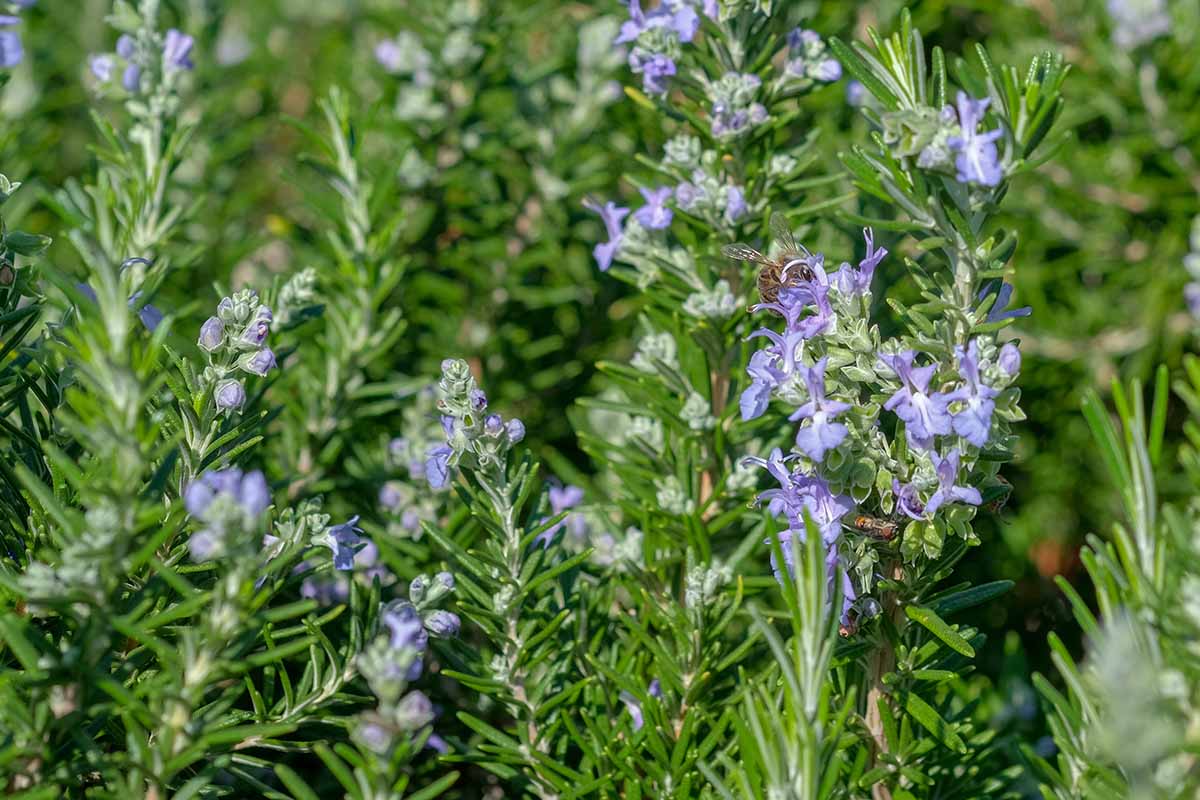
Most cultivars of this herb are hardy to Zone 9, but you’ll find some that can withstand Zone 6 winters. They prefer full sun and can rise to majestic heights of four to six feet with a spread of six to eight feet.
Rosemary blooms intermittently throughout the growing season.
It makes an attractive and functional specimen in a mixed bed and adds a pleasantly pungent fragrance to walkway border gardens. Showcase dahlias against a backdrop of rosemary’s silvery-green needle-like foliage.
‘Arp’ is a cold-hardy cultivar that’s suitable for cultivation in Zones 6 to 10. You can find find two- and four-packs of plants in #1 containers available at Nature Hills Nursery.
Our rosemary growing guides have all you need to get underway.
16. Snapdragon
A sun-loving perennial in Zones 7 to 10 and an annual elsewhere, snapdragon (Antirrhinum majus) has upright spikes of rainbow-colored, two-lipped blossoms.
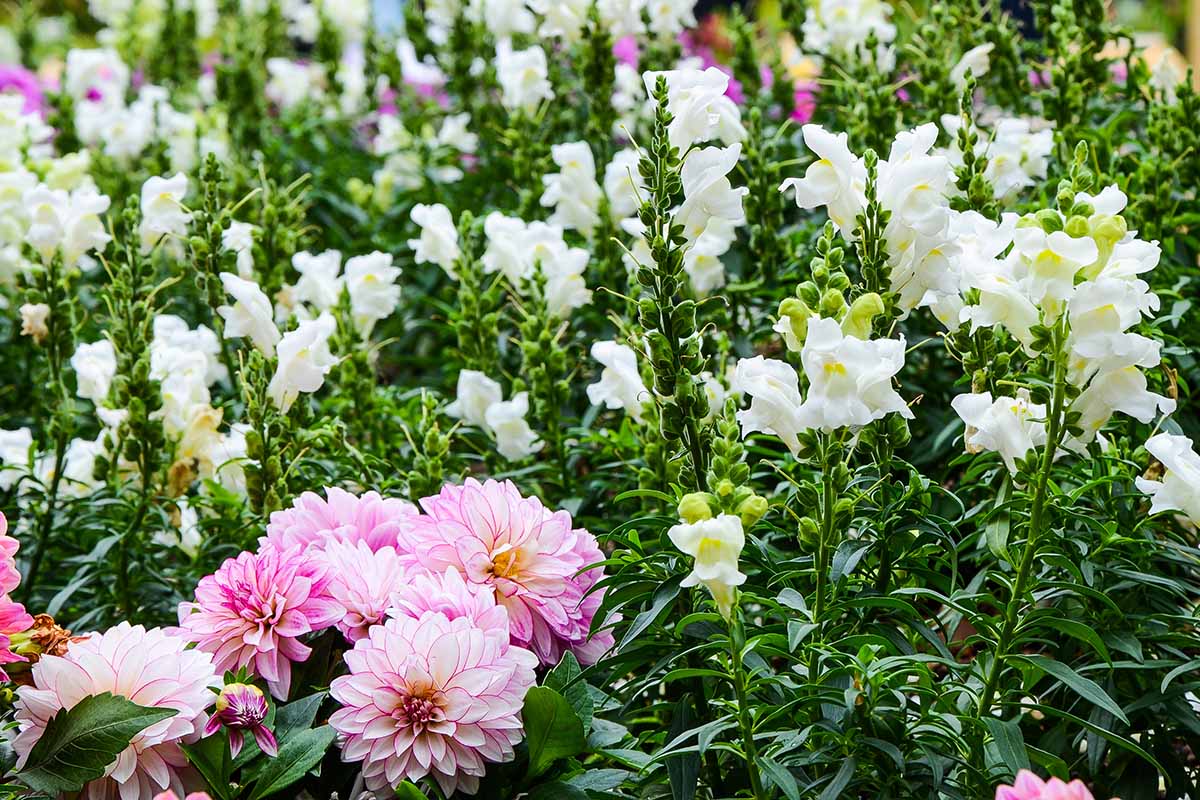
Heights range from eight to 36 inches and widths from six to 12 inches. There are sizes and colors to match or contrast with dahlias of all statures.
A cottage garden staple, snapdragon always delivers. Expect optimal blooming in the coolness of spring and fall.
The Madame Butterfly Mix is available from Burpee in packets of 50 seeds. This mix features bronze, cream, pink, red, rose, and yellow flowers for a stunning display.
Learn more about how to grow snapdragons in our guide.
17. Sneezeweed
From late summer through fall, native perennial sneezeweed (Helenium autumnale) graces landscapes in Zones 3 to 8 with bright yellow, orange, or red blooms. Daisy-like, these have triangular petals and prominent mustard-yellow centers.

Sun-loving sneezeweed is a tall plant that tops out at three to five feet with a spread of two to three feet.
Pair it with matching or contrasting dahlias of a similar height in a substantial drift for an outstanding meadow-like display.
Helenium Mariachi™ ’Salsa’ is a red variety that’s available in #1 containers from Nature Hills Nursery.
18. Turtlehead
The blossom spikes of native perennial turtlehead (Chelone obliqua) resemble snapdragons with hooded, lip-like petals in pink, purple, and white. They grow in full sun to part shade in Zones 5 to 9, where they bloom from summer to fall.
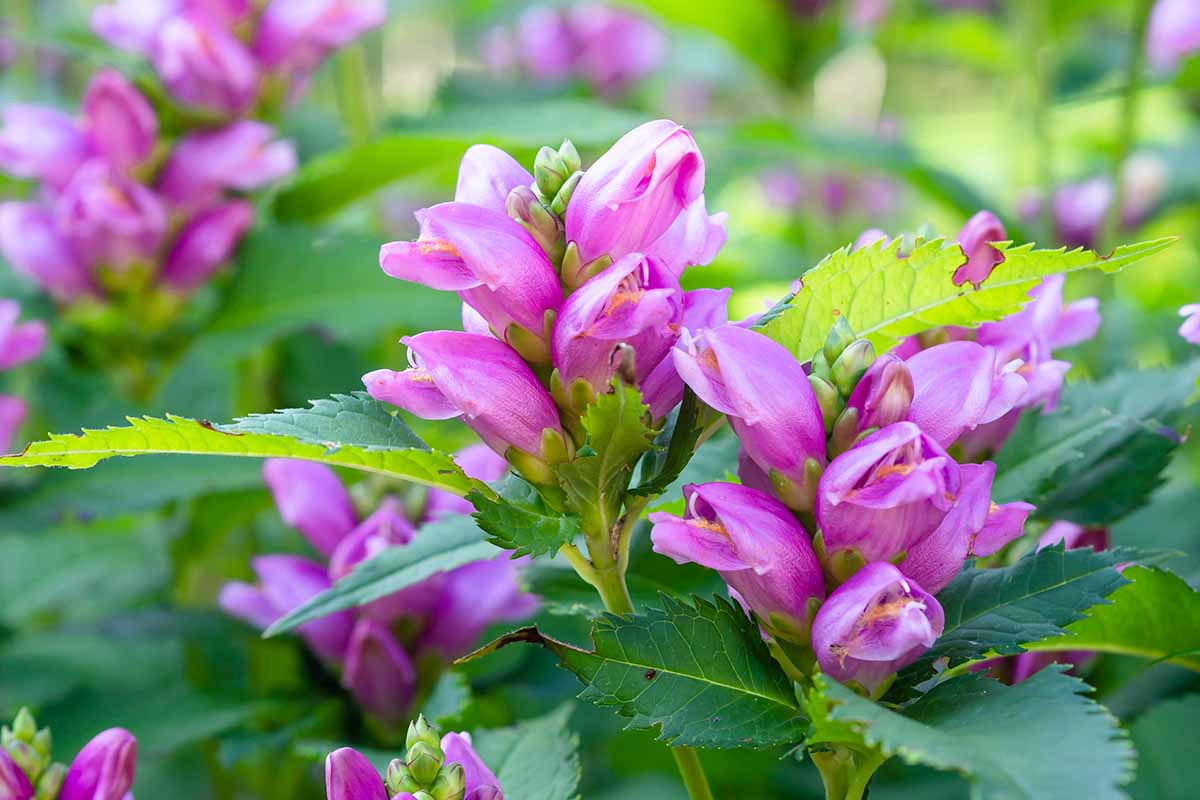
With heights of two to three feet and widths of one to two feet, their vertical interest and compact form make them well-suited to mid-bed placements as a backdrop to smaller dahlias in front.
19. Zinnia
Annual zinnias (Zinnia spp.) grow in Zones 2 to 11 from summer through fall, glorying in full sun in a broad spectrum of colors ranging from brilliantly saturated to understated pastel.
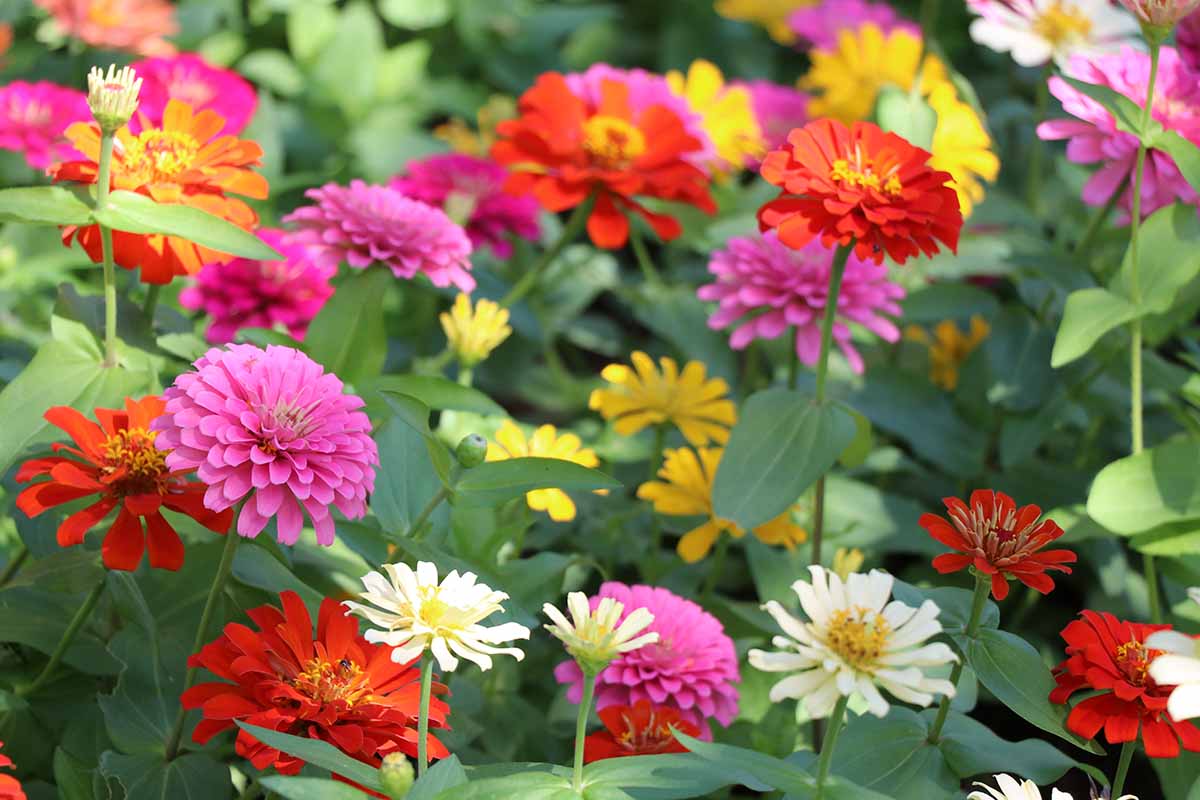
Dwarf varieties are available with heights of six to 12 inches tall. Full-size cultivars may soar to four feet.
Widths vary from one to two feet. Turn the color up or down to play a supporting role in beds and borders, as well as cottage and cutting gardens.
Pumila Mix is a colorful mixture of heirloom zinnias in a variety of different colors, including red, pink, orange, rose, and white. You can find seeds available from Eden Brothers.
Our guide to growing zinnias provides cultivation instructions. Our roundup showcases 15 beautiful cultivars for your garden.
Get Creative with Colorful Companions
When selecting companion plants, consider mature dimensions to allow room for adequate airflow without overcrowding.
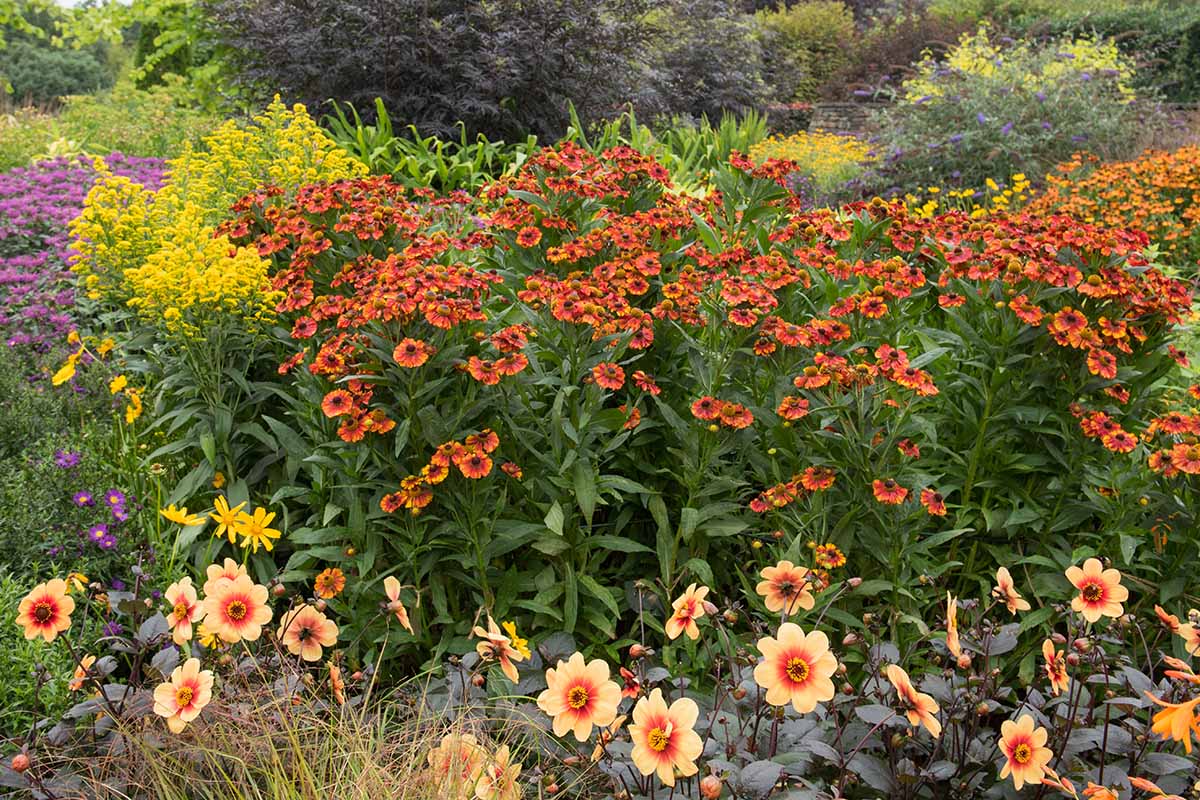
When purchasing new plants, set the pots in experimental groupings at the nursery to see what excites you.
Did you know that arranging plants in odd numbers, like three or five, has more visual appeal than pairing in even numbers, such as two or four?
Try alternating flower species, as mentioned, to create pleasing rhythms and balance that guide the eye through a landscape.
When selecting colors, remember that pastels, like pinks and lavenders, calm and refresh, while hot colors, like bright oranges and reds, enliven and stimulate.
Perhaps you might pair purple and yellow, complementary or opposite colors that make each other pop with intensity.
Use white as a palette cleanser to transition between colors or create an all-white or monochromatic garden that glows invitingly at dusk.
With 19 dahlia companion plants from which to choose, it’s time to let your imagination run wild!
And finally, make things easy on yourself by installing an irrigation system for simple and efficient one-size-fits-all watering for your dahlias and their culturally compatible pals.
Do you grow dahlias in the company of other culturally similar plants? Please tell us all about your garden in the comments section below.
If you found this article informative, we recommend the following dahlia guides next:
